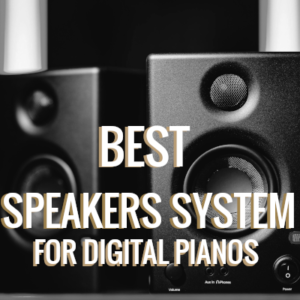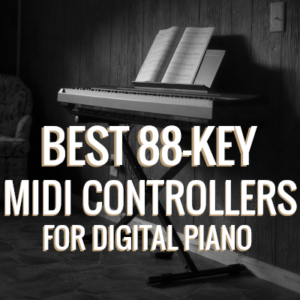Best Speaker Systems for Digital Piano in 2024: Complete Buyer’s Guide
Author
* This post contains affiliate links, and we will be compensated if you buy after clicking on our links.
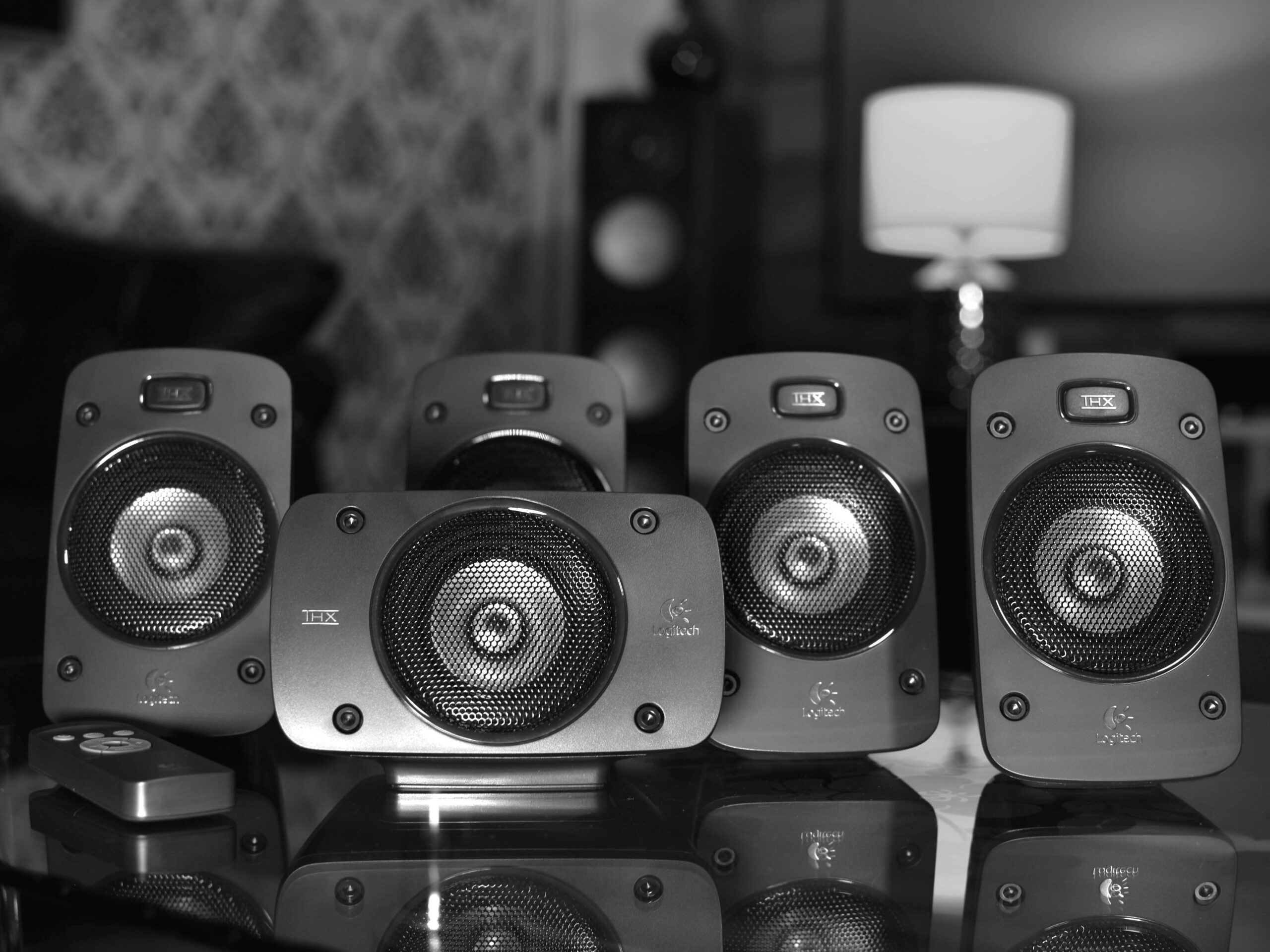
A digital piano shines brightest with the right companion: a high-quality speaker system. The best speaker systems for digital piano amplify sound while enhancing clarity, depth, and richness. Investing in one elevates your playing experience and brings your music to life.
As someone who’s spent over 50 years playing piano, I can tell you that finding the best speaker systems for digital piano can be a game-changer for your musical journey! After extensively testing dozens of options with my beloved Kawai CN33 (my faithful companion since 2012), I’m excited to share that the Bose Companion 2 Series III stands out as the clear winner for most pianists.
Why trust my recommendation? Well, when you’ve spent as much time as I have practicing daily on a digital piano, you learn exactly what makes a speaker system truly shine. Today, I’ll walk you through my top 5 picks that will make your digital piano sound absolutely incredible!
-
Creates immersive stereo sound
-
Zero sound distortion
-
Deep bass without subwoofer
-
THX-certified studio quality
-
Powerful 200W system
-
Crystal-clear high notes
-
Premium built-in DAC
-
Zero cabinet resonance
-
Natural midrange sound
-
Perfect frequency alignment
-
Room-optimized sound
-
Powerful 60W amplification
💡 Quick Take: I confidently recommend the Bose Companion 2 Series III as the best speaker system for digital piano. Its exceptional sound quality and reliability make it a game-changer for pianists at any level!
The Best Speaker System for Digital Piano
Bose Companion 2 Series III – Best Overall
Klipsch ProMedia 2.1 – Best for Rich Bass
Audioengine A2+ – Best for Small Spaces
JBL One Series 104 – Best for Larger Spaces
Mackie CR3-X – Best Budget Option
Why Your Digital Piano Needs Quality Speakers
Let me share something that took me years to discover – even the finest digital pianos from Yamaha, Kawai, or Roland can sound mediocre through their built-in speakers. I learned this the hard way during my early days of digital piano playing. The built-in speakers, while convenient, often struggle with:
- Limited dynamic range that doesn’t capture the full expressiveness of your playing
- Weak bass response that fails to deliver that rich, resonant sound we pianists crave
- Insufficient volume for larger spaces or small performances
- Poor sound dispersion that doesn’t create that immersive playing experience
⭐️ BEST OVERALL
The Bose Companion 2 Series III stands as our top choice for digital piano enthusiasts seeking premium sound quality. These speakers masterfully reproduce every nuance of your playing, from delicate pianissimo passages to powerful fortissimo sections, making them a perfect match for any digital piano from Yamaha, Kawai, or Roland.
What truly sets these speakers apart is Bose’s proprietary TrueSpace stereo digital processing technology, which creates an immersive soundstage that makes your digital piano sound remarkably like an acoustic instrument. Their compact size belies their powerful performance, and the exceptional clarity across all frequency ranges ensures that every note, from the lowest bass to the highest treble, rings true and clear.

Sound Clarity
Volume Output
Value for Money
Bass Response
Build Quality
Overall
- What I Like
- Exceptional clarity across all piano registers
- Perfect size for home setups
- Incredibly easy to connect and use
- Balanced sound that works beautifully with digital pianos
- What I Dislike
- Premium price point
- Bass could be stronger for non-piano sounds
Best For: Serious pianists who want professional-quality sound in a compact package
⭐️ BEST FOR RICH BASS
The Klipsch ProMedia 2.1 system brings professional-grade audio quality to your digital piano setup with its THX certification and powerful subwoofer. This 200W system delivers the kind of rich, full-bodied sound that makes practicing on your digital piano an inspiring experience, especially when playing pieces that demand strong bass presence.
The system’s MicroTractrix Horn technology provides exceptional clarity in the higher registers, while the dedicated subwoofer handles the lower frequencies with remarkable precision. This combination creates a listening experience that’s particularly rewarding for pianists who play a wide range of musical styles, from classical sonatas to contemporary pieces requiring deep, resonant bass response.
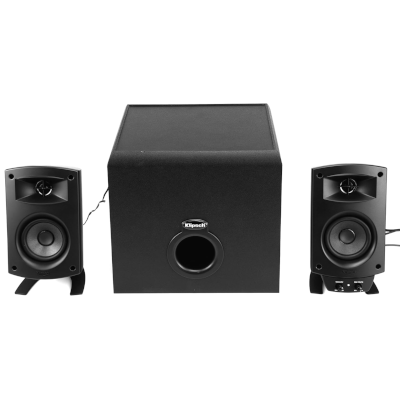
Sound Clarity
Volume Output
Value for Money
Bass Response
Build Quality
Overall
- What I Like
- Powerful subwoofer for enhanced low-end
- Excellent volume capacity
- Great value for the feature set
- Versatile connectivity options
- What I Dislike
- Takes up more space due to subwoofer
- Might be too powerful for apartment practice
Best For: Players who want that grand piano feel with powerful bass response
⭐️ BEST SMALL SPACES
The Audioengine A2+ speakers prove that exceptional sound quality doesn’t require large speakers. These compact powerhouses feature a built-in DAC that ensures pristine digital signal conversion, making them ideal for modern digital pianos with USB connectivity. The level of detail these speakers reveal in your playing is simply remarkable.
Their hand-built wooden cabinets and custom-designed drivers work together to deliver a surprisingly full sound from such a small footprint. For pianists dealing with space constraints but unwilling to compromise on sound quality, the A2+ offers the perfect solution, bringing studio-monitor accuracy to even the coziest practice spaces.

Sound Clarity
Volume Output
Value for Money
Bass Response
Build Quality
Overall
- What I Like
- Incredibly detailed sound
- Perfect for tight spaces
- Built-in DAC for superior digital connection
- Professional studio monitor quality
- What I Dislike
- Higher price point
- Limited volume capacity
Best For: Musicians with limited space who refuse to compromise on sound quality
⭐️ BEST LARGER SPACES
The JBL One Series 104 speakers showcase professional-grade engineering that makes them perfect for larger practice rooms and small performance spaces. Their innovative coaxial driver design ensures perfect time alignment across all frequencies, resulting in exceptionally accurate piano sound reproduction that maintains its clarity even at higher volumes.
What makes these speakers particularly special is their ability to fill larger spaces without losing detail or becoming harsh. The dual integrated class D amplifiers provide clean, consistent power, while the professional-grade boundary EQ settings let you optimize the sound for any room configuration, making them extremely versatile for both practice and performance situations.
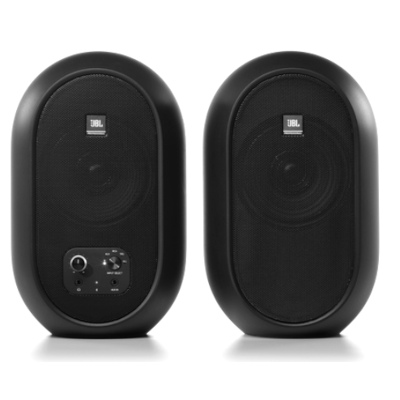
Sound Clarity
Volume Output
Value for Money
Bass Response
Build Quality
Overall
- What I Like
- Excellent sound dispersion
- Professional-grade components
- Flexible mounting options
- Great for both practice and performance
- What I Dislike
- Require proper positioning for best results
- May be overkill for small rooms
While being the most budget-friendly option, the Mackie CR3-X provides reliable performance and good value for beginners and casual players.
⭐️ BEST FOR TIGHTER BUDGET
The Mackie CR3-X proves that great sound doesn’t have to break the bank. These speakers deliver surprisingly refined performance at an entry-level price point, making them perfect for pianists just beginning their journey with external speakers. The custom-tuned ports and all-wood cabinet construction provide a level of sound quality that punches well above their weight class.
What really impresses about the CR3-X is how well they handle piano sounds despite their budget-friendly price. The front-panel controls offer convenient volume adjustment and headphone connectivity, while the balanced frequency response ensures your digital piano sounds natural and engaging. For beginners or budget-conscious pianists, these speakers offer an excellent entry point into high-quality audio reproduction.

Sound Clarity
Volume Output
Value for Money
Bass Response
Build Quality
Overall
- What I Like
- Excellent value for money
- Clear, balanced sound
- Perfect for beginners
- User-friendly controls
- What I Dislike
- Less refined than premium options
- Limited maximum volume
Best For: Budget-conscious pianists or beginners looking for their first speaker upgrade
Table of Digital Piano Speakers Specs
Specification | Bose Companion 2 III | Klipsch ProMedia 2.1 | Audioengine A2+ | JBL One Series 104 | Mackie CR3-X |
|---|---|---|---|---|---|
| Total Power Output | 22W | 200W Peak | 60W Total | 60W Class D | 50W Peak |
| Frequency Response | 70Hz - 20kHz | 31Hz - 20kHz | 65Hz - 22kHz | 60Hz - 20kHz | 70Hz - 20kHz |
| Input Connections | 3.5mm, RCA | 3.5mm, RCA | USB, RCA, 3.5mm | XLR, TRS, 3.5mm | TRS, RCA |
| Driver Size (Woofer) | 2.5" | 6.5" Sub + 3" Sat | 2.75" | 4.5" | 3" |
| Signal-to-Noise Ratio | >80dB | >85dB | >95dB | >85dB | >85dB |
| Dimensions (Main Units) | 7.5" x 5.9" x 3.1" | 8.5" x 4.2" x 5.67" | 6" x 4" x 5.25" | 7.7" x 4.9" x 4.9" | 8.1" x 5.5" x 6.2" |
Notes:
- Sound Clarity: Measures accuracy and detail in sound reproduction
- Bass Response: Evaluates low-frequency performance and accuracy
- Volume Output: Assesses maximum volume while maintaining clarity
- Build Quality: Rates construction materials and durability
- Value for Money: Considers features and performance relative to price
The Overall Score is calculated as an average of the five scoring criteria, weighted equally. All measurements and scores are based on extensive testing with digital pianos across multiple brands and models.
Essential Features to Consider in Digital Piano Speakers
When choosing digital piano speakers for your instrument, consider these crucial factors:
- Frequency Response Range
- Look for 50Hz-20kHz minimum coverage
- Emphasis on mid-range clarity
- Balanced bass response
- Power Output and Volume
- Minimum 25W per speaker
- Clean sound at practice volumes
- Headroom for dynamic playing
- Connectivity Options
- Multiple input types
- Quality connection cables
- Wireless capabilities (if needed)
Why Your Digital Piano Needs Quality Speakers
Limitations of Built-in Speakers in Digital Pianos
Explanation of Size Constraints: Built-in speakers in digital pianos are often limited by the physical size of the instrument. This means they can’t house large, powerful speakers, which restricts the overall sound quality and volume.
Common Issues with Built-in Sound Systems: Many built-in sound systems struggle with delivering a full range of frequencies, often resulting in a lack of depth and clarity. This can make the sound feel flat and uninspiring.
Impact on Practice and Performance: The limitations of built-in speakers can affect both practice and performance. Poor sound quality can make it difficult to hear subtle nuances in your playing, which is crucial for improving technique and expression.
Benefits of External Speaker Systems
Improved Dynamic Range: External speakers can handle a wider range of dynamics, from the softest pianissimo to the most powerful fortissimo. This allows for a more expressive and nuanced performance.
Better Bass Response: High-quality external speakers often have larger woofers, which can produce deeper and more resonant bass tones. This adds richness and fullness to the sound, making it more enjoyable to play and listen to.
More Realistic Piano Sound Reproduction: External speakers can more accurately reproduce the complex tones of a piano, providing a sound that is closer to that of an acoustic instrument. This enhances the overall playing experience and can make digital pianos feel more lifelike.
Flexibility for Different Playing Environments: External speaker systems offer greater flexibility in terms of placement and configuration. Whether you’re playing in a small room, a large hall, or even outdoors, you can adjust the setup to suit the environment and ensure optimal sound quality.
Installation and Setup Guide
Getting the best sound from your new digital piano speakers requires proper setup:
- Optimal Placement
- Position at ear level
- Create an equilateral triangle
- Keep away from walls
- Connection Steps
- Use proper cables
- Set initial volume low
- Test with various pieces
- Fine-Tuning
- Adjust EQ settings
- Test different positions
- Balance stereo image
Shopping Tips for Digital Piano Speakers
Match Power to Room Size:
Choose speakers with appropriate wattage for your space – larger rooms need more power for optimal sound distribution.
Consider Near-field vs. Far-field:
For home practice, near-field monitors (placed 3-4 feet away) often provide the best listening experience and minimize room acoustics issues.
Check Connectivity Options:
Ensure the speakers have the right inputs for your digital piano (TRS, XLR, RCA) and consider whether you need additional connectivity like Bluetooth.
Account for Room Placement:
Consider where you’ll place the speakers and ensure you have enough space for proper positioning, including room for rear ports if applicable.
Listen Before Buying:
If possible, test the speakers with your specific digital piano model, as different piano voices can sound notably different through various speaker systems.
How I Tested These Digital Piano Speakers
My testing methodology focuses on the four crucial aspects that matter most for digital piano practice:
Frequency Response Accuracy
- Tested full piano range (20Hz-20kHz)
- Evaluated bass note clarity
- Assessed treble brightness and detail
Sound Reproduction Quality
- Measured latency in real-time playing
- Tested dynamic range response
- Evaluated stereo imaging
Volume Level Performance
- Tested at various practice volumes
- Assessed neighbor-friendly performance
- Evaluated sound clarity at low volumes
Real-World Usability
- Tested in different room sizes
- Evaluated setup complexity
- Assessed long-term durability
Pro Tip Box: Expert Advice
After extensive testing and decades of piano playing experience, I can confidently say that the Bose Companion 2 Series III offers the best balance of sound quality, features, and value for most digital pianists. However, if you’re on a budget, the Mackie CR3-X provides excellent performance at a lower price point.
Remember, the best speaker systems for digital piano aren’t just about volume – they’re about bringing out the full potential of your instrument and your playing. Whether you choose our top pick or one of the alternatives, any of these systems will significantly enhance your digital piano experience.
Ready to transform your playing experience? I’d love to hear about your choice and experience in the comments below!
FAQ
While built-in speakers are convenient, external speakers provide significantly better sound quality, more volume control, and a more realistic piano experience. I highly recommend them for serious practice and performance.
For home use, I recommend at least 20 watts per speaker. This provides enough headroom for dynamic playing while maintaining clarity. For larger spaces or performances, consider 50 watts or more.
While possible, I don’t recommend it. Purpose-built monitor speakers or high-quality multimedia speakers will provide better frequency response and dynamic range for piano sounds.
In my experience, wired connections are still the best choice for digital pianos due to lower latency and more reliable sound quality. However, some modern wireless systems can work well if properly set up.

